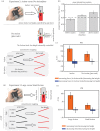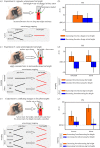Binding space and time through action
- PMID: 25808892
- PMCID: PMC4389624
- DOI: 10.1098/rspb.2015.0381
Binding space and time through action
Abstract
Space and time are intimately coupled dimensions in the human brain. Several lines of evidence suggest that space and time are processed by a shared analogue magnitude system. It has been proposed that actions are instrumental in establishing this shared magnitude system. Here we provide evidence in support of this hypothesis, by showing that the interaction between space and time is enhanced when magnitude information is acquired through action. Participants observed increases or decreases in the height of a visual bar (spatial magnitude) while judging whether a simultaneously presented sequence of acoustic tones had accelerated or decelerated (temporal magnitude). In one condition (Action), participants directly controlled the changes in bar height with a hand grip device, whereas in the other (No Action), changes in bar height were externally controlled but matched the spatial/temporal profile of the Action condition. The sign of changes in bar height biased the perceived rate of the tone sequences, where increases in bar height produced apparent increases in tone rate. This effect was amplified when the visual bar was actively controlled in the Action condition, and the strength of the interaction was scaled by the magnitude of the action. Subsequent experiments ruled out that this was simply explained by attentional factors, and additionally showed that a monotonic mapping is also required between grip force and bar height in order to bias the perception of the tones. These data provide support for an instrumental role of action in interfacing spatial and temporal quantities in the brain.
Keywords: ATOM; crossmodal correspondence; magnitudes; temporal estimation.
© 2015 The Author(s) Published by the Royal Society. All rights reserved.
Figures



References
MeSH terms
Grants and funding
LinkOut - more resources
Full Text Sources
Other Literature Sources

